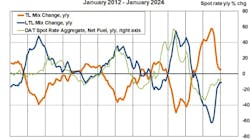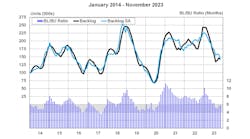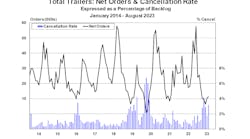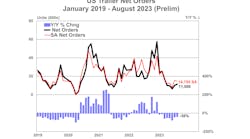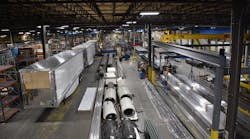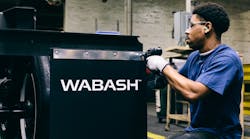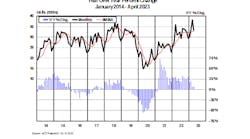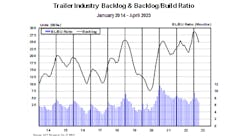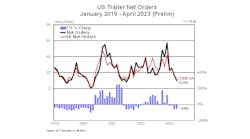The horse trailer manufacturing industry took a 10% hit in 2007 and likely will take the same hit in 2008, but production and sales of living quarters trailers have been largely unaffected.
That was one of the surprising results uncovered by Jeremy Brahm in his report, “Horse Trailer Manufacturing in North America,” for SpecialtyVehicles.net, a boutique consultancy and business publications firm in the United States that specializes in providing proprietary business analysis and databases to the medium/heavy vehicular, body, engine, equipment, trailer, and component manufacturing industries worldwide.
Brahm said the living quarters (LQ) niche will be down just 50 units in 2008 — or 0.6% — despite the economic downturn and fuel-price crisis that are hammering the rest of the trailer industry. He theorized that the customers who can afford one of these units — with a top price of $200,000 — probably aren't as likely to be affected by fuel prices.
“Companies are still building the $200,000 units,” he said. “I've been told that living quarters are still selling well, but it's the other markets, like bumper pulls, that aren't as popular. People with the money to spend for living quarters trailers will still spend it. With bumper-pull trailers, which are inexpensive, people will put off buying those.
“The high-end market is not affected by the consumer credit crunch. Customers who can afford the high-end living quarters trailers will spend whatever they want and do not normally place restrictions on the amount that they will spend.”
Brahm said that with many young families involved in horse-related activities, the demand for larger LQ trailers is greater. As boomers age, the demand for smaller LQ trailers will increase, as children leave home and the number of horses requiring transportation in each trailer decreases.
However, he said, the LQ market probably will remain unchanged during the next three years. The increase in demand for smaller LQ trailers could offset the decrease in demand for the larger LQ trailers.
Two units in one
Brahm said the attractiveness of the LQ trailers is rooted in the idea that they're basically two units in one.
“Living quarters give you the ability to have the RV portion and the horse portion,” he said. “The problem with that is they are a heavier unit. With gas prices being what they are, let alone diesel, people might have to buy a bigger truck. You're kind of damned if you do and damned if you don't. But if you do, at least you have the RV portion — the dining and sleeping area — instead of having to buy a horse trailer and a RV.”
He said their price range goes from $20,000 to $200,000, but it's nearly impossible to cite an average price.
“The challenge is that living quarters are very customized, so the range for them is very wide,” he said. “If you get a six-horse trailer, you're looking at $150,000 to $200,000. Somebody might want a 40“ HD TV, as opposed to 35“. Slide-outs go for between $5000 and $8000. Also, do they want exotic hardwood panels? Some even have granite in the trailers.”
Brahm said an estimated 8158 LQ trailers are produced annually in North America, with an estimated sales value of $323 million.
Brahm said projecting out to 2010, the total sales dollars of all horse trailers will go up but the number of units will go down. Bumper-pulls will be down 6.5% this year, and despite an upswing in the next two years, they won't reach the 2007 level.
The overall horse trailer manufacturing industry has an estimated dollar value of $713 million, with an estimated 38,175 horse trailers produced.
Featherlite is the top player, followed by Sundowner, CM Trailers Inc, W-W Trailer, and Exiss. These top five companies contribute about 25.3% of the market share.
Bumper-pulls are the most common type of horse trailers produced in North America, at 46.3%, with 17,657 units. Their sales value is estimated at $168 million, contributing about 23.6% of the total horse trailer sales. They rank last in terms of sales value.
Gooseneck trailers without LQ rank second in terms of units, at 32.4%, with 12,360 units and sales value of $221 million, or 31%. Gooseneck trailers are the preferred type of trailers for hauling more than two horses.
LQ contribute 21.4% in unit sales with 8158 units, but rank first in sales value at $323 million (45.4%).
View on mergers
Brahm said that based on his research and interviews conducted at trade shows, the merger of Exiss/Sooner and Featherlite has not been well-received.
Featherlite was purchased by Universal Trailer Corp in October 2006. Universal already owned the Exiss, Sooner, and Haulmark (cargo trailer) brands when Featherlite was acquired.
“It has not panned out very well,” Brahm said. “A number of people said Sooner made good trailers, and now when they look at an Exiss, Sooner, or Featherlite trailer, it's very hard to distinguish between them.
“The brands didn't really play off each other because they required that everybody keep their own dealers, which is very strange because you have three separate brands. Wouldn't you consolidate? They didn't. It's one thing if you only had one dealer in one area, but they all just kind of slammed on top of each other. Featherlite at least was diversified, but with Exiss and Sooner, their products pretty much overlapped. Most people said, ‘You have these brands and now they look the same. How am I supposed to tell between them?’ ”
“It shows that, in my opinion, if people are going to merge companies, they really have to think it out better. All three literally fell on top of each other. It's a waste of time and effort because you really didn't expand anywhere. It's like you're selling in your same market. Whereas if you had bought something in the Southeast or Northwest or Northeast, you would have said, ‘I can cover a couple of areas.’ Yes, they did have the ability to consolidate manufacturing costs and purchase steel at a cheaper price. One manufacturer said that Universal was actually able to get a dime per pound of steel ordered cheaper. So the cost of manufacturing is cheaper from a raw-material standpoint.”
On the other hand, Brahm said CM Trailers' October 2007 merger with Big Tex Trailers — which also included CM's affiliate, S&H Trailers — made a lot of sense.
“That is a very good diversification because Big Tex does not participate in the horse trailer market,” he said. “Right now, with the way raw material prices are, anything you can do to reduce the overall manufacturing cost is going to help business as a whole. Big Tex was one of the bigger companies on the overall market. In our previous Specialty Trailer manufacturing report, we had them as top 10 overall manufacturer. Now this acquisition will produce current annual revenues that exceed $225 million.”
Some trends Brahm noted:
- Aluminum versus steel.
Brahm said the percentage of horse trailers manufactured with aluminum frames is estimated to be greater than the percentage of those manufactured with steel frames.
“There is no clear indication of preference among customers with regard to steel or aluminum frames. However, it is estimated that there is a growing preference among customers for either all-aluminum trailers or trailers with steel frame and aluminum skin. Of the 87 manufacturers identified, 36 manufacture horse trailers with only aluminum frames, 40 manufacture horse trailers with only steel frames, and 11 manufacture trailers with both aluminum frames and steel frames.
“There is a trend to manufacture steel-aluminum combination trailers, with steel frame and aluminum skin. The future of horse trailer manufacturing is considered to be the composite-built trailer, using a variety of technologically advanced materials. Galvanized steel (dipped protected against rust), galvanneal steel (electrochemically treated against rust), powder-coated steel (baked against rust), fiberglass, and a variety of other new products are appearing on the market every year.”
- Few barriers to entry.
“Horse trailer manufacturing is an extremely competitive industry because it has relatively few barriers to entry. All that is needed to enter this business is the ability to purchase steel and/or aluminum, axles, lighting, adhesive tape, tires, bending and welding equipment. The majority of manufacturers in this industry have only one manufacturing facility, so there are a large number of regional manufacturers, indicating a steady demand for this product and ease of entry into this segment.
“Lakota and Blue Ribbon are two new entrants into the market, each only two years old, but they are already producing more than 250 units. The steady demand for this product enables easy entry into this product segment.”
- In-house production.
“One thing companies try to do in order to increase profitability is to produce the living quarters units in-house. By doing the conversion work in-house, companies are able to sell products at a higher price, but also with higher margins. However, this strategy is more expensive due to the following factors: manpower and experience needed to customize these units; accessibility to manufacturers of customization gear for recreational vehicles (such as wood paneling, cushions, sinks, etc); and with the customization of the unit, there is less standardization in the manufacture of the trailer.
“Companies that produce the complete unit try to have standard portions of the trailer shell, but they do make modifications based on the number of slide-outs that the customer requires. The majority of living quarters manufacturers ship the trailer shell to independent conversion companies. However, some companies enter into agreements with conversion companies, whereby the conversion of living quarters is done in the manufacturer's facility itself and the trailers do not leave the manufacturer's facility for outside conversion. This leads to improved product quality.”
- Consolidation.
“There is no unanimity on the benefits of consolidation among manufacturers in this industry right now. A few manufacturers feel that this is the right time for consolidation, while some are of the opinion that there will be no consolidation in the industry at the present time.
“I'm hoping there will be more consolidation. There is overcapacity. One manufacturer, Shadow Trailers, just built a brand new facility in Florida. I was shocked. Why would you be building a facility with the way the market is now? It just doesn't make any sense to me. But there will still be a lot of people who think they can make money because it's a very easy market to enter. Even companies like Lakota, which has more experience with the RV market, got into this market. Blue Ribbon, which I had never heard of, within three years of starting was building 500 units. You're a decent regional player if you can build 500 units.
“It's still amazing to me how many people can get into this market. It's a very dynamic market. People will come in, do well, fall out. Truck bodies aren't as dynamic as these. Everybody is just very stubborn: ‘I can do it better than they can.’”
To order the report, go to www.SpecialtyVehicles.net and click on the link “Horse Trailer Manufacturing Industry in North America.” Published price is $2750, but there is a 30% discount for those who use the coupon code TBHORSE or mention Trailer/Body Builders magazine. Price after discount is $1925. For more information on the SVN report, call 209-576-8021 or e-mail [email protected].
